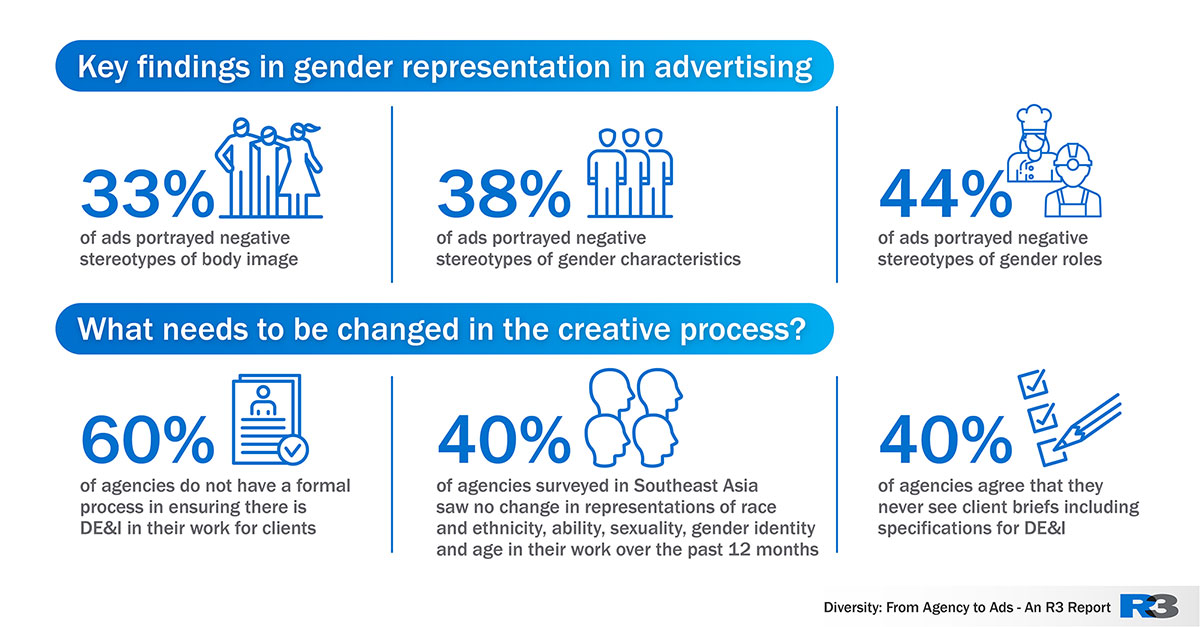By Shufen Goh, Principal & Co-founder, R3 – As professionals working in Southeast Asia’s multicultural region, we walk a line between respect for tradition and investment in the future. One gives us roots while the other gives us wings. As a Singaporean, co-owner of a global business, a mother, and a member of the marketing community, this dichotomy has long been of interest to me, particularly in the areas of gender, sexuality, roles, and representation in advertising.
Finding a DE&I Framework
To better inform our approach in this area, R3 has undertaken studies over the past two years to better understand how marketing in Southeast Asia can develop its own framework for Diversity, Equity, and Inclusion.
We are only one of many organizations trying to gauge the temperature of how companies are performing in this area, but a key issue we wanted to address in the design of this year’s study was how many DE&I surveys produced outcomes that were highly subjective and too abstract for C-suite decision-makers.
So we focused our attention on two questions: Is there a correlation between gender representation in advertising and the people who create them (agencies)? And how involved are clients in the process?
An Imbalance in Focus
What we found in this year’s review is that agencies aren’t doing too bad. Women are represented in leadership (45% to male 55%), with slightly more women in overall roles (58%). Advertising across Singapore, Thailand, Malaysia, Indonesia, and the Philippines, and Hong Kong were mostly respectful to genders though a number of narratives were told from a male perspective and framed women in negative roles.
What gave us real concern was that DE&I initiatives were largely centered on culture-building, and 60% of agencies did not have any formal process to ensure diversity and inclusion in their work. Awareness around DE&I is growing, but it is not a requirement in deliverables!

Procurement to the Rescue
While we need to nurture workplace cultures that are affirmative of individual identity, giving too much focus on getting the culture right can eclipse an area where change can be more quickly felt – change at a contractual level.
The power of weaving Diversity, Equity, and Inclusion into contracts is to make action non-debatable. Once an agreement is contractual, it can be audited, and all parties kept accountable. Having things be “optional” leaves the door open to bias and makes good intent vulnerable to roadblocks.
Minimizing Opportunity for Bias
The fact is we cannot completely rely on experience to determine action. Humans are easily distracted and impressionable. We need guidelines and processes to keep us on track. Research has shown that people can have as many as 188 cognitive biases at any one time, ranging from “Familiarity Bias” (preference for what we know) to “Anchoring Bias” (often occurring in salary negotiations).
If we take the finding from R3’s study on gender representation in advertising that 44% of ads in Southeast Asia promote negative gender roles and consider the outcome if every client or agency had a clause in their contract that required a review of scripted roles across Inclusive criteria, then the argument is clear. The addition of a few small steps in the overall process can positively impact our media and marketing.
A Show of Commitment
To change experience, we need to address the building blocks of business. If we can ensure that our contracts include clauses that require diversity, equity, and inclusion, we have taken care of the most basic elements of creative engagement. This will lead to more equitable representation in our stories, with our storytellers and better narratives. We need to deliver work that is diverse and inclusive, and clients need to demand it. Without it, we will only be creating ambiance without making real commitment.





